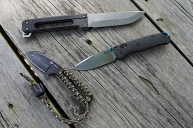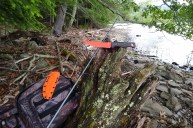We wanted to know, so we asked: What should you look for in a knife?
It's always a worthwhile practice to ask what sort of knives hunters, survivalists, everyday carriers, and others own and why. There's no better teacher than experience, so we turned to several trusted Wide Open Spaces outdoor writers to get their opinions.
Responding to the question, "What do you look for in a knife?" here's what they said:
Chris Buckner
A hunter since childhood, Chris is a National Champion call maker with Buckner Custom Calls, winning the National Wild Turkey Federation's call-making competition twice now for his crow calls.
"A great knife is all about balance and durability. Balance is all about size, you want a knife big enough to tackle any job but small enough to not be cumbersome. A good knife is durable in both the fact that it can be used in a wide variety of ways, and that it is able to retain its sharp edge for extended periods without re-sharpening."
Our take: You're right, Chris. Balance and durability are essential to whatever you carry. When you can carry only one knife, it's good to find one that has both features. You might like a knife like the North Fork; the blade steel is CPM-S30V, which proves versatile because of its combination of durability and edge retention.
David Smith
David's enduring passion for hunting, fishing and foraging, as well as wild game and catch recipes, led him to create Creative Sustenance, a wild edibles blogsite and soon-to-be-published companion cookbook.
I look for four main things in a knife:
A heavy blade with a very thick, smooth, 90-degree spine (no serrations).
A handle that is comfortable and fully fits the hand and is non-slip. While I prefer bone, antler and wood for its aesthetic value, synthetic materials are hard to say no to.
Steel: an S30V, S35VN or 420HC are good choices. Of course I also like a forged knife, and am acquainted with some bladesmiths whose work is exceptional.
In blade style I prefer a slight drop point or a clip point.
I know I said four things and that is true concerning the knife, but the sheath is also important. I have come to like a good kydex sheath, wrapped in leather, and with attachments like a fire starter, stone, places to add cordage. I like a horizontal belt position as well.
Our take: Over the years, we've learned that many hunters find themselves compromising between the aesthetics they want and the utility features they need. David, we're thrilled to see that you almost perfectly described the Bushcrafter 162-1. We built this with hunters and all-around outdoorsmen in mind, giving you that heavy blade and easy-to-grip handle you're looking for, paired with one of your preferred steels.
Eric Nestor
When not in the woods, Eric is usually nose-deep in historical outdoorsman writings and the like. He prefers the primitive way of being an outdoorsman and is constantly researching and perfecting his craft.
A good knife should hold a keen edge and feel lively in your hand. The knife must be the right size for the job and give the user a firm grip even when wet or covered with blood from field dressing. A safe scabbard or folding ability will keep the ever sharp blade on the knife from cutting the user during transport.
Our take: An interesting (and important) point about personal safety when it comes to sheathing and folding. It can be tricky to find a solid folder that's also grippy enough to break down game, but the new 560 Freek was designed to accommodate the requirements you mention. The new dual-durometer handles are softer and more tacky right in the places where you grip the knife to keep it stable. The blade shape also features an abnormally high main bevel, making it a tremendous slicer. And it's tough to beat the safety of the AXIS® lock!
Craig Raleigh
Craig has fished everywhere from the Merritt Dam in Cherry County, Nebraska, to the Cumberland River in Nashville, Tennessee. With a conservationist heart instilled in him by his father and grandfather, he lives for the chance to get outside and discover. He is also the author of two books.
It's got to be a fixed blade with full tang and the hardest steel I can get. I want a solid butt in case I want/need to pound with it. The sheath doesn't have to be stylish, but I always look for a handsome inlay in the handle.
Our take: In a fixed blade being used for anything besides decorative purposes, we believe full tang (which means the knife steel extends through the entire length of the handle to the hilt) should be a given. Although we don't recommend hammering things with the butt end, you might find the Fixed Contego Family is tough enough to satisfy your requirements, and has a distinctive look to boot.
Dustin Prievo
A career firefighter with the Baltimore City Fire Department and owner of a mobile DJ Business, DJ Prievo Entertainment, Dustin can be found in one of three places; work, home, or the outdoors. He hunts with a group, helps manage several farms in Maryland and spends his October and November each year traveling the Northeast to Midwest region hunting and filming for his outdoor team, Top Pin Outdoors.
Three things I look for in a quality hunting knife:
Good, High-Quality Steel (The harder the steel, the longer that edge will last in the field)
Comfort of use.
Customer Service. This is a big one with me, often times a tip can break or something fails, and with good customer service, you never have to worry about using the knife to its full potential.
Our take: Glad you mentioned it, Dustin. As part of our lifetime warranty, we do our best to go above and beyond for our customers by providing LifeSharp services for all Benchmade knives—meaning, we'll gladly resharpen any Benchmade blade to factory standards free of charge.
Micah Sargent
Micah Sargent grew up in the woods of north-central Pennsylvania and started hunting at the age of 12. Today, he pursues whitetail deer, wild turkeys, black bear, and small game with a rifle, shotgun, recurve bow and muzzleloader.
For me, a knife needs to start sharp, stay sharp, and be easy to sharpen if it gets dull. It needs to fit my hand well and be comfortable to use. A brightly colored handle helps me keep track of it when gutting and skinning jobs run into the nighttime hours.
Our take: Many of our customers, hunters in particular, find that CPM-S30V, with a smooth, non-serrated blade, is the easiest kind of blade to sharpen. You might like the 15008-ORG Steep Country knife, which is super easy to sharpen, designed for easy game processing, and available in safety orange.
So, there you have it, some sound advice, and a few suggestions to follow up. Hopefully you've got a better idea of the knife options you have, and you know where to go to find what you need.
NEXT: BENCHMADE KNIVES LIVE AT SHOT SHOW 2017




